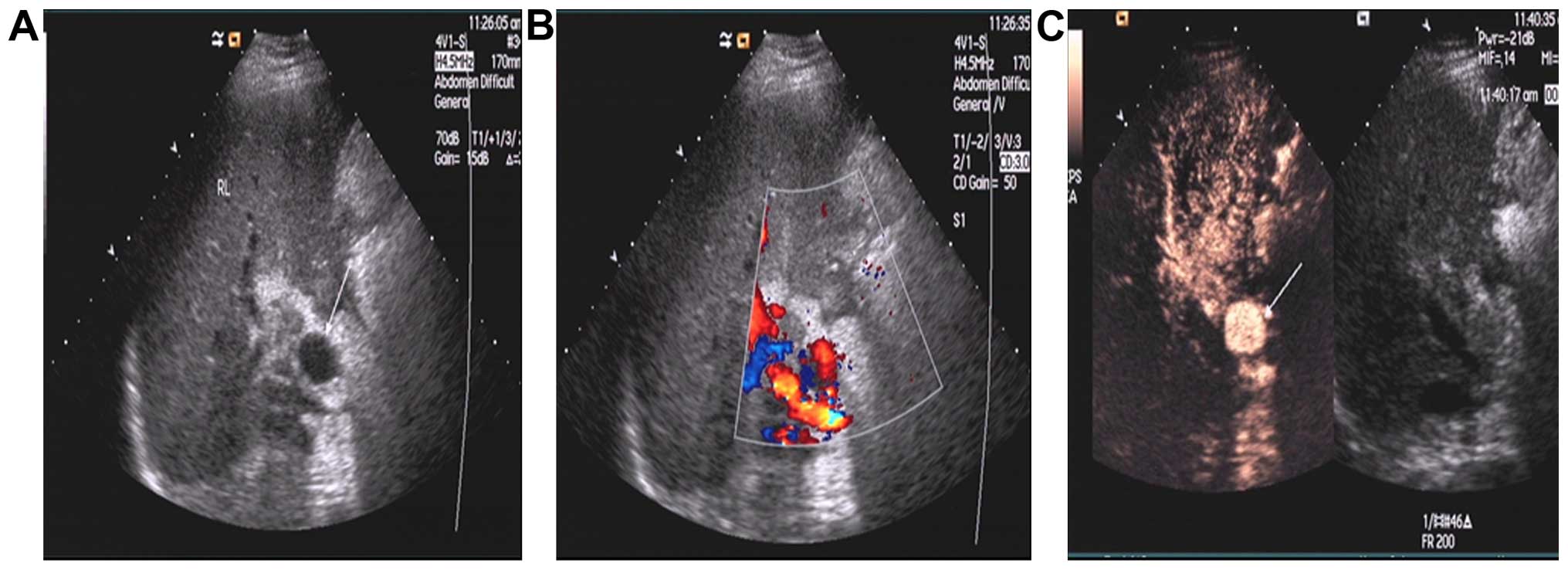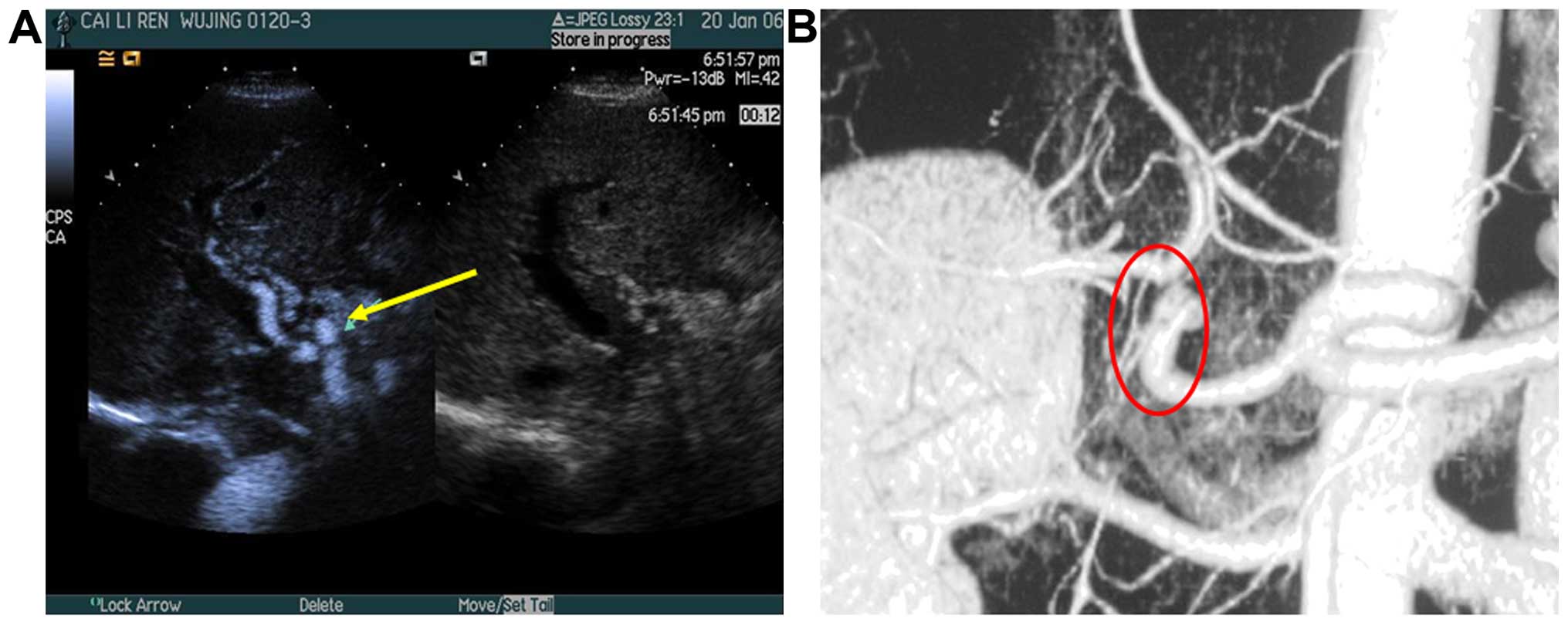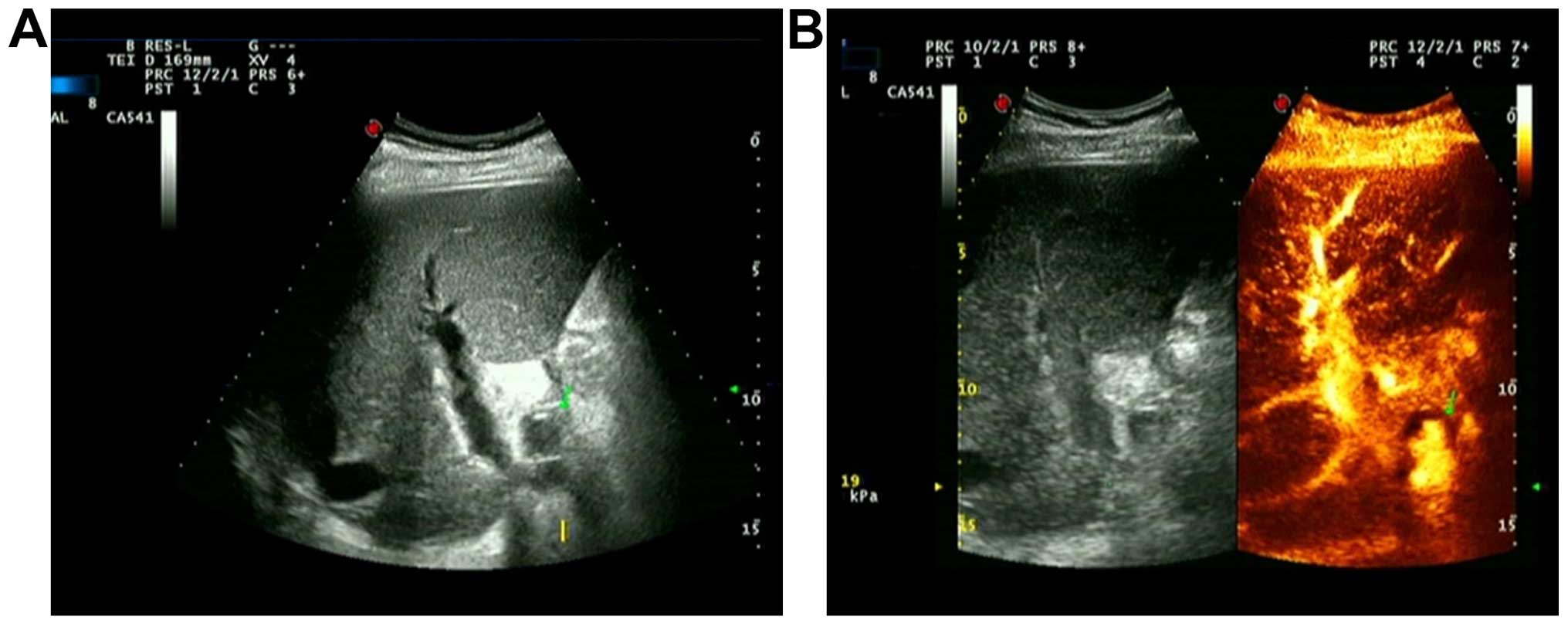|
1
|
Volpin E, Pessaux P, Sauvanet A, Sibert A,
Kianmanesh R, Durand F, Belghiti J and Sommacale D: Preservation of
the arterial vascularisation after hepatic artery pseudoaneurysm
following orthotopic liver transplantation: Long-term results. Ann
Transplant. 19:346–352. 2014. View Article : Google Scholar : PubMed/NCBI
|
|
2
|
Nghiem HV: Imaging of hepatic
transplantation. Radiol Clin North Am. 36:429–443. 1998. View Article : Google Scholar : PubMed/NCBI
|
|
3
|
Luo Y, Fan YT, Lu Q, Li B, Wen TF and
Zhang ZW: CEUS: A new imaging approach for postoperative vascular
complications after right-lobe LDLT. World J Gastroenterol.
15:3670–3675. 2009. View Article : Google Scholar : PubMed/NCBI
|
|
4
|
Rennert J, Dornia C, Georgieva M, Roehrl
S, Fellner C, Schleder S, Stroszczynski C and Jung EM:
Identification of early complications following liver
transplantation using contrast enhanced ultrasound (CEUS). First
results. J Gastrointestin Liver Dis. 21:407–412. 2012.PubMed/NCBI
|
|
5
|
Wertheim JA, Petrowsky H, Saab S,
Kupiec-Weglinski JW and Busuttil RW: Major challenges limiting
liver transplantation in the United States. Am J Transplant.
11:1773–1784. 2011. View Article : Google Scholar : PubMed/NCBI
|
|
6
|
Pakosz-Golanowsha M, Lubikowski J, Post M,
Jarosz K, Zasada-Cedro K, Milkiewicz P and Wójcicki M: The arterial
anastomosis in liver transplantation: Complications, treatment and
outcome. Hepatogastroenterology. 57:1477–1482. 2010.PubMed/NCBI
|
|
7
|
Singhal A, Stokes K, Sebastian A, Wright
HI and Kohli V: Endovascular treatment of hepatic artery thrombosis
following liver transplantation. Transpl Int. 23:245–256. 2010.
View Article : Google Scholar : PubMed/NCBI
|
|
8
|
Yang Y, Zhao JC, Yan LN, Ma YK, Huang B,
Yuan D, Li B, Wen TF, Wang WT, Xu MQ, et al: Risk factors
associated with early and late HAT after adult liver
transplantation. World J Gastroenterol. 20:10545–10552. 2014.
View Article : Google Scholar : PubMed/NCBI
|
|
9
|
Frongillo F, Lirosi MC, Nure E, Inchingolo
R, Bianco G, Silvestrini N, Avolio AW, De Gaetano AM, Cina A, Di
Stasi C, et al: Diagnosis and management of hepatic artery
complications after liver transplantation. Transplant Proc.
47:2150–2155. 2015. View Article : Google Scholar : PubMed/NCBI
|
|
10
|
Hamby BA, Ramirez DE, Loss GE, Bazan HA,
Smith TA, Bluth E and Sternbergh WC III: Endovascular treatment of
hepatic artery stenosis after liver transplantation. J Vasc Surg.
57:1067–1072. 2013. View Article : Google Scholar : PubMed/NCBI
|
|
11
|
Fistouris J, Herlenius G, Bäckman L,
Olausson M, Rizell M, Mjörnstedt L and Friman S: Pseudoaneurysm of
the hepatic artery following liver transplantation. Transplant
Proc. 38:2679–2682. 2006. View Article : Google Scholar : PubMed/NCBI
|
|
12
|
Saad WE, Dasgupta N, Lippert AJ, Turba UC,
Davies MG, Kumer S, Gardenier JC, Sabri SS, Park AW, Waldman DL, et
al: Extrahepatic pseudoaneurysms and ruptures of the hepatic artery
in liver transplant recipients: Endovascular management and a new
iatrogenic etiology. Cardiovasc Intervent Radiol. 36:118–127. 2013.
View Article : Google Scholar : PubMed/NCBI
|
|
13
|
Thorat A, Lee CF, Wu TH, Pan KT, Chu SY,
Chou HS, Chan KM, Wu TJ and Lee WC: Endovascular treatment for
pseudoaneurysms arising from the hepatic artery after liver
transplantation. Asian J Surg. Aug 30–2014.(Epub ahead of print).
View Article : Google Scholar : PubMed/NCBI
|
|
14
|
Girometti R, Como G, Bazzocchi M and
Zuiani C: Post-operative imaging in liver transplantation:
State-of-the-art and future perspectives. World J Gastroenterol.
20:6180–6200. 2014. View Article : Google Scholar : PubMed/NCBI
|
|
15
|
Tada T, Kumada T, Toyoda H, Ito T, Sone Y,
Kaneoka Y, Maeda A, Okuda S, Otobe K and Takahashi K: Utility of
contrast enhanced ultrasonography with perflubutane for determining
histologic grade in hepatocellular carcinoma. Ultrasound Med Biol.
41:3070–3078. 2015. View Article : Google Scholar : PubMed/NCBI
|
|
16
|
D'Onofrio M, Crosara S, De Robertis R,
Canestrini S and Mucelli RP: Contrast-enhanced ultrasound of focal
liver lesions. AJR Am J Roentgenol. 205:W56–W66. 2015. View Article : Google Scholar : PubMed/NCBI
|
|
17
|
Fontanilla T, Noblejas A, Cortes C, Minaya
J, Mendez S, Van den Brule E, Hernando CG, Alfageme M, Baños I and
Aguirre E: Contrast-enhanced ultrasound of liver lesions related to
arterial thrombosis in adult liver transplantation. J Clin
Ultrasound. 41:493–500. 2013. View Article : Google Scholar : PubMed/NCBI
|
|
18
|
Zheng RQ, Mao R, Ren J, Xu EJ, Liao M,
Wang P, Lu MQ, Yang Y, Cai CJ and Chen GH: Contrast-enhanced
ultrasound for the evaluation of hepatic artery stenosis after
liver transplantation: Potential role in changing the clinical
algorithm. Liver Transpl. 16:729–735. 2010.PubMed/NCBI
|
|
19
|
Lee SJ, Kim KW, Kim SY, Park YS, Lee J,
Kim HJ, Lee JS, Song GW, Hwang S and Lee SG: Contrast-enhanced
sonography for screening of vascular complication in recipients
following living donor liver transplantation. J Clin Ultrasound.
41:305–312. 2013. View Article : Google Scholar : PubMed/NCBI
|
|
20
|
Cosgrove D and Harvey C: Clinical uses of
microbubbles in diagnosis and treatment. Med Biol Eng Comput.
47:813–826. 2009. View Article : Google Scholar : PubMed/NCBI
|
|
21
|
Sanyal R, Zarzour JG, Ganeshan DM,
Bhargava P, Lall CG and Little MD: Postoperative Doppler evaluation
of liver transplants. Indian J Radiol Imaging. 24:360–366. 2014.
View Article : Google Scholar : PubMed/NCBI
|
|
22
|
Goel A, Mehta N, Guy J, Fidelman N, Yao F,
Roberts J and Terrault N: Hepatic artery and biliary complications
in liver transplant recipients undergoing pretransplant
transarterial chemoembolization. Liver Transpl. 20:1221–1228. 2014.
View Article : Google Scholar : PubMed/NCBI
|

















